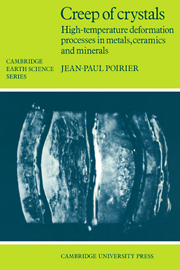Book contents
- Frontmatter
- Contents
- Preface
- 1 Mechanical background
- 2 The agents of deformation: lattice defects
- 3 Phenomenological and thermodynamical analysis of quasi-steady-state creep
- 4 Dislocation creep models
- 5 The effect of hydrostatic pressure on deformation
- 6 Creep polygonization and dynamic recrystallization
- 7 Diffusion creep, grain-boundary sliding and superplasticity
- 8 Transformation plasticity
- 9 Scaling and classification
- References
- Materials index
- Subject index
9 - Scaling and classification
Published online by Cambridge University Press: 06 October 2009
- Frontmatter
- Contents
- Preface
- 1 Mechanical background
- 2 The agents of deformation: lattice defects
- 3 Phenomenological and thermodynamical analysis of quasi-steady-state creep
- 4 Dislocation creep models
- 5 The effect of hydrostatic pressure on deformation
- 6 Creep polygonization and dynamic recrystallization
- 7 Diffusion creep, grain-boundary sliding and superplasticity
- 8 Transformation plasticity
- 9 Scaling and classification
- References
- Materials index
- Subject index
Summary
After examining the various high-temperature deformation mechanisms in the preceding chapters, it is proper to step back and take a look at all the possible deformation mechanisms for a given material according to mechanical criteria. This is a considerable job, but it has recently been done for us in a book by Frost & Ashby (1982). Our last chapter will therefore be nothing more than a sketchy summary of the subject matter of their book.
Scaling
Prior to any attempt to compare and classify objects or behaviours, one must make sure to compare only comparable quantities. We have already seen that a temperature of 100 °C has not the same meaning for indium, which melts at 157 °C, and magnesium oxide, which melts at 2852 °C. It follows that the comparison of the deformation behaviour of materials can only be made on the basis of properly scaled, dimensionless quantities (hydrodynamicists proceed in the same way).
The obvious and widely used normalizing parameters for temperature and stress are the absolute melting temperature and some elastic modulus (preferably μ), so that the dimensionless parameters are T/Tm and σ/μ. However, this choice is not the only one and it may not even be the best (Frost & Ashby, 1982): energies per molar volume have the dimension of stresses, and energies over the Boltzmann constant k have the dimension of temperature.
- Type
- Chapter
- Information
- Creep of CrystalsHigh-Temperature Deformation Processes in Metals, Ceramics and Minerals, pp. 229 - 235Publisher: Cambridge University PressPrint publication year: 1985



